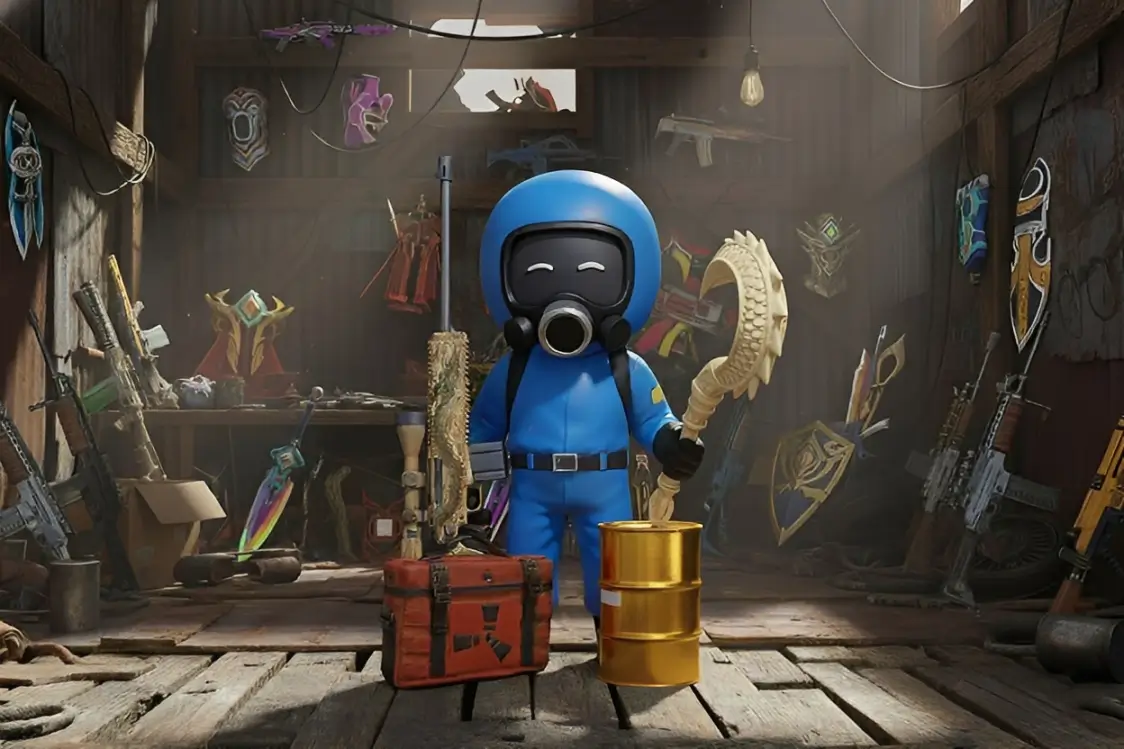What Are Rust Skins and How Does Their Economy Work
Skins in Rust are cosmetic items (weapons, clothing, doors, dеcor) that change the appearance of in-game objects. Some of them can confer a gameplay edge, but most carry collectible value and deliver aesthetic appeal. The Rust skins economy rests on three pillars:
1. Scarcity and rarity. Most unique items are released in limited runs, and some appear only once as seasonal or themed collections.
2. Community demand. Pricing is driven by in-game fashion and content creation — streams, videos, screenshots. The more often an item shows up “on camera,” the stronger the interest — classic supply and demand at work.
3. Trading infrastructure. Deals happen on the Steam Market and third-party marketplaces with P2P mechanics, bots, escrow, and their own fees. The flow of trades creates a “live” skins market with visible price charts and volumes.
Crucially, this isn’t a conservative investment — it’s trading virtual assets with a high share of speculative demand and risk.
Price Drivers: Rarity, Popularity, Visual Appeal
- Rarity and supply. Limited releases and discontinued skins tend to be more liquid. The harder an item is to get, the stronger the price support.
- Set/theme popularity. Collections tied to recognizable style packs (camo, neon, sci-fi) that track in-game trends are more likely to spark demand.
- Gameplay advantage. Sets like Whiteout, Forest Raider, Desert Raider, and Blackout can offer an edge in certain biomes (e.g., Blackout at night), and players willing to gain that edge are ready to pay a premium.
- Visual readability. Skins that pop in inventory and screenshots gain organic exposure via content.
- Price history and volume. Smooth price charts (without one-off spikes) and healthy daily volume indicate skin liquidity.
- Seasonality and events. Updates, events, and Steam sales move the market: you’ll often see good volatility into events and pullbacks afterward.
- Community utility. If streamers/servers use a skin frequently, it gains “social utility,” which supports demand.
Most Liquid Categories
Based on the Rust skins market, the fastest-moving items are:
- Weapons. AK, MP5, Thompson — top attention slots. Easier price discovery, more buyers, and plenty of historical data.
- Clothing/armor. Masks, chest pieces, gloves, kilts, hoodies, and jeans—benefit from cohesive set looks.
- Doors and build pieces. Door skins are a Rust classic: highly visible and common in servers and videos.
- Tools. Pickaxes, hatchets, hammers: not always the highest margin, but easy for average players to value—low barrier to entry.
- Crates (storage). High liquidity thanks to constant use. Skins help label loot categories quickly and show up in screenshots/streams. Set/bright designs and “meta” crate lines boost demand.
- Walls and décor. Highly visible inside bases and in tour/raid videos, which keeps them on buyers’ radars.
These items see frequent use, steadier demand, and regular content exposure — meaning it’s easier to sell near fair market value without long listing times.
Risks: Low Liquidity, Off-Platform Scams, Trade Bans, Fees

Skin investing always balances risk and return. Individual items can suffer from low demand, so liquidity is often limited — especially with niche designs or rare skins that lack steady turnover. Another risk is off-platform fraud: any deal “around” trusted marketplaces raises the chance of losing money or receiving the wrong item. Stick to reputable platforms with escrow and 2FA.
Operational frictions matter, too: trade bans and holds can freeze assets at the worst moment, while fees eat into profits — the Steam Market takes a cut (plus potential game-specific fees), which directly affects resell economics and breakeven levels. Volatility is significant as prices react to sales, patches, and content hype; short “wicks” up and down are normal. Track volume and price charts to gauge real market depth. Finally, there’s ecosystem risk: rule changes in the game or marketplaces, tweaks to the economy, or format changes can shift behavior unexpectedly. Plan how to choose skins for investment ahead of time, use conservative scenarios, and have an exit plan.
Where and How to Buy/Sell: Steam Market vs. Third-Party Platforms
Steam Community Market
- Pros: native to the ecosystem, handy charts, clear rules, strong baseline liquidity for popular items.
- Cons: limited pricing flexibility, Steam and game fees, no direct cash-out to bank accounts (funds remain in Steam).
How to operate:
1. Analyze price and volume history (charts + volumes).
2. Place buy orders slightly below market to catch dips.
3. Plan exits net of fees so your target price clears costs and leaves profit.
4. Watch for catalysts (patches, big streams, etc.) — they create short-term liquidity windows.
Third-Party Marketplaces
- Pros: lower fees, flexible pricing, P2P mechanics, more flipping scenarios.
- Cons: scam risk if you pick the wrong venue, due diligence required on counterparties, KYC/AML rules, possible limits/holds.
How to operate:
1. Choose reputable platforms with escrow and responsive support.
2. Enable 2FA and verify “official” bots/accounts lists.
3. Compare current pricing and spreads between Steam and external markets — arbitrage pops up at times.
4. Test new venues with small amounts to learn real settlement and withdrawal speeds.
Quick Comparison: Other Games’ Virtual Assets (CS2 & Dota 2)

CS2
Huge audience and exceptional liquidity for top tiers (knives, gloves, rare stickers). Competition is tougher, and anti-cheat/fee environments are stricter. Blue-chip items are less volatile; niche ones swing more.
Dota 2
A long tail of collectibles — arcanas, couriers, sets. Liquidity is lower than in CS, but unique items with history can behave like trading cards.
Rust
Rust sits in between: higher engagement with décor/building, steady demand for weapons/clothing/doors. Fewer institutional speculators than in CS, leaving more room for niche finds and mid-ticket flips on the Rust skins market.
Takeaway
The Rust skins market is competitive — especially if you can read community behavior and track content trends across marketplaces.
Strategies: Long-Term vs. Short-Term, Diversification, Targets & Exits
Long-Term
- What to buy: limited runs, key set pieces, rare skins (doors/weapons) with durable demand.
- Logic: bet on scarcity and cultural value; hold longer and add on pullbacks.
- Metrics: steady volumes on charts, organic demand history, visible fan base.
Short-Term / Speculation
- What to trade: hype events, news, new collection drops, temporary spikes.
- Logic: buy into liquidity dips, trade quick reversals, exploit cross-market spreads.
- Risk management: lock in profits by rules you set in advance; use stop-zones with fees in mind.
- Micro-plays:
1. Marketplace arbitrage: price gaps between Steam and P2P venues.
2. Set-complete: buy the missing piece of a hot set and sell as a bundle.
3. Event trading: enter 1–3 days pre-event, exit on peak volume.
Diversification
- By category: weapons (liquidity core), clothing (set stories), doors/crates/walls (high visibility), plus 1–2 “experimental” items.
- By horizon: 60–70% long-term; 20–30% mid-term; 10–20% fast trades.
- By venue: some on Steam (safety/data), some on external markets (flexibility/fees).
Targets & Exit Points
Set and document your profit target (e.g., +15–25% after fees) along with a holding horizon, then revise your plan when the trend turns: watch for shrinking volumes, support breaks on the chart, or the item dropping out of content focus. Don’t “fall in love” with assets — skins are merchandise, not trophies, if your goal is profit. That mindset underpins rational skin investing.
Common Rookie Mistakes and How to Avoid Them
- Chasing hype without volume. A sharp pop on thin trading is a falling-knife setup—always check liquidity.
- Ignoring fees. Paper profits can flip to losses after fees. Calculate net results.
- Over-concentration. Don’t park the whole bankroll in one item or category. Diversify.
- Off-platform deals. Saving on fees can cost you everything. Use trusted marketplaces.
- No exit plan. No target = no profit taking. Define levels in advance.
Tracking & Portfolio Metrics
Keep a table with required fields: item, category, entry date, entry/exit price, venue fee, net return, and notes (events, content triggers). For quality control, use KPIs: turnover speed (avg time from buy to sell), win rate (share of trades with positive net), max drawdown (largest drop from peak), and concentration (weight of your largest position — keep it in check).
Bottom Line
The Rust skins market is viable but high-risk. Profits go to those who pair hard numbers with a feel for community behavior. Discipline is everything: count margins after fees, track liquidity and volatility, plan entries and exits in advance, and don’t hold “favorites” longer than the market allows.
🎮If you don’t have any skins to start investing yet, head over to Cobalt Lab. You can build your starting bankroll there!




